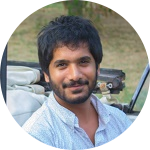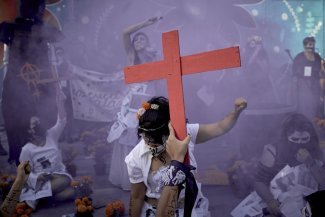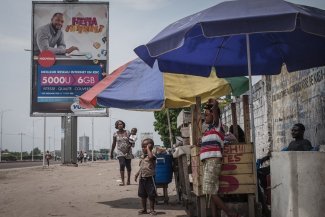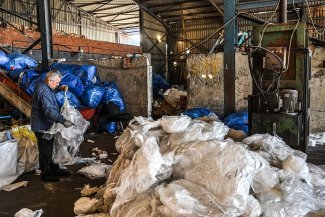On 9 July 2018, Kashmiri journalist Fahad Shah rushed home to find an active tear gas cannister in his living room. “The tear gas shell was fired through the window, into the room where my parents usually offer their prayers,” he wrote on Facebook. “There is smoke everywhere. My mother is still struggling to breathe. Incidents like these and many others are the reasons why the Kashmiri youth is [sic] turning to violent means of resistance.”
Speaking to Equal Times, Shah described the situation in Indian-Administered Kashmir (IAK) – one of the most militarised zones in the world – as “chaotic and desperate”. The picturesque valley is the site of a long-standing political conflict, the intractability of which is most commonly attributed to “a zero-sum clash of national pride” between India and Pakistan. The neighbouring countries have fought three wars over IAK, an area with a population of about 12 million, 70 per cent of which are Muslim. In 2016, a new wave of violent protests broke out in the valley, resulting in hundreds dead and thousands injured. “I am a journalist, but I feel like an obituary writer,” says Shah.
For many Kashmiris in IAK, the presence of an active tear gas cannister – most often used to disband public protests – inside of a sacred, private space is an apt metaphor for the violent and intrusive political repression they experience.
Yet, international narratives of the conflict seldom make any reference to reasons why people in IAK are violently opposed to the state. In May, a New York Times editorial on Kashmir came under fire for raising the bogeyman of religious militancy as a way of undermining the genuine aspirations of the people in the valley, whose “struggle for freedom and self-determination predates the partition,” according to a rebuttal published on the Al-Jazeera website.
For Riyaz Wani, a journalist based in Kashmir’s biggest city, Srinagar: “There is undoubtedly a geopolitical dimension to the conflict,” but he believes that simplistic ideas about the nature of religious militancy in the region end up playing into the hands of the occupation. This is how the occupation produces legitimacy for itself, “by dismissing criticisms as inauthentic and/or illegitimate”.
History of a conflict
In 1947, British Colonial India broke into two independent states: the Muslim-majority Pakistan and the Hindu-majority India. Kashmir was a Princely State of the British empire, consisting of a Muslim-majority population ruled by the repressive Hindu Dogra.
Princely states were given the choice of joining India, joining Pakistan or becoming independent. The Kashmiri maharaja, Hari Singh, first chose independence, but under pressure from invading Pashtun tribal forces from Pakistan, he eventually acceded to India.
Indian and Pakistani forces clashed with each other, before calling a ceasefire and establishing “the line of control” – a military line that divided Kashmir into the Pakistan-administered regions of Azad Kashmir and Gilgit-Baltistan, and the Indian-controlled regions of Jammu, Kashmir and Ladakh. In 1949, a plebiscite was promised to the populations of the Indian-held territory, but it never materialised.
Since that time, skirmishes over the de facto border have frequently occurred, resulting in civilian deaths on both sides. India continues to accuse Pakistan of sponsoring religious militancy in Kashmir and maintains an occupying force of over 250,000 soldiers.
“Pretty much every grievance is seen through the lens of this dynamic,” says a source who asked to remain anonymous. “Any agitation against state policy is perceived as support for militancy. The state is in denial of its own faults.”
Given Pakistan’s dismal human rights record, it is obvious that its intervention in Kashmir is driven by national pride, rather than a genuine respect for self-determination. However, in the increasingly essentialist discourses peddled by India’s ruling Hindu-nationalist Bharatiya Janata Party (BJP), detractors of the occupation are often portrayed as treasonous terrorists. But religious militancy is only one facet of this complex and protracted conflict.
A political climate of abject hopelessness has mobilised sympathy for a new generation of militants. The rise of BJP has intensified anti-Muslim fervour in India, polarising religious communities. Hindu lynch mobs have attacked and killed many Muslims over false rumours and petty religious offences. This has further alienated the already embittered Kashmiri Muslims, who feel even more pessimistic about a peaceful and democratic resolution to the conflict in the current circumstances.
A new wave of militancy
According to several analysts interviewed by Equal Times, the cruel, rigid policies of the Indian state are giving legitimacy to a new wave of militant activity. Burhan Wani was a 22-year-old militant who reportedly joined an armed insurgency after he and his brother were beaten up by the police when he was just 15 years old. Wani became a Kashmiri folk-hero after Indian security forces killed him in an encounter in 2016. His funeral was attended by an estimated 200,000 people and his death resulted in major unrest.
Like Wani, many militants are reported to have taken up arms in response to traumatic experiences endured at the hands of the state. Moreover, with 70 per cent of the valley’s male residents under the age of 35 and male youth unemployment at roughly 41 per cent, young men are left susceptible to radicalisation by groups that glorify martyrdom in service of a higher purpose.
When Wani was killed, the late prominent journalist and editor Shujaat Bukhari (who was also murdered earlier this year) raised an important question in an article he penned for the BBC: “Is Burhan Wani more dangerous to India now that he is dead? The challenge the government now faces is fighting the ideology that Wani promoted, clearly reflected in the outpouring of sentiment over his killing.”
Delhi’s response to these challenges is unlikely to restore any faith in peaceful resolutions, now exhausted by decades of abuse and unaccountability. Two popular ‘uprisings’ in 2008 and 2010 saw the death of more than 200 people, many of them civilian protesters killed by Indian forces.
In 2016, when Kashmir erupted in protests following Wani’s murder, security forces indiscriminately fired ‘non-lethal’ shotgun pellets at protesters, killing hundreds and injuring thousands. An estimated 728 of these injuries were in the eye and skull areas, resulting in what the Guardian termed as “the world’s first mass blinding”.
In 2016, Peer Viqar Ul Aslam and Syed Faisal set up the Save The Eyes Foundation, which helps the now visually-impaired victims of metal shotgun pellets in Kashmir. “I have met victims as young as 10, completely bereft of hope. Most victims come from low-income households, [and they are] unable to foot the medical bills associated with years of rehabilitative surgeries and therapy,” says Aslam.
“We can all agree that religious terrorism is a cancer in our societies but what about state-terrorism?” adds Aslam. “Kashmiri youth are educated and are searching for political solutions to this conflict. However, by not giving them any political freedom, the Indian state is creating a vacuum that can only be filled by violent groups.”
“Immunity from prosecution”
According to a report published by the Office of the United Nations High Commissioner for Human Rights (OHCHR), Indian security forces enjoy broad powers, backed by laws such as the Armed Forces Special Powers Act (AFSPA) which grant them “effective immunity from prosecution”.
In addition, the Public Safety Act (PSA) allows authorities to detain civilians for a broad range of vaguely-defined activities, such as “acting in any manner prejudicial to the maintenance of public order”. This offense includes gathering in a group of more than five people. The PSA also allows for detention without charge or trial for up to two years and diminishes “any real possibility for detainees to contest the legality of their detention.”
The report further states that “PSA has reportedly been used widely by the authorities in Jammu and Kashmir to stifle dissent. It has been used to target human rights defenders, journalists, separatist political leaders, suspected members of armed opposition groups and people involved in protests.”
Moreover, many Kashmiris feel like they can no longer turn to their local political parties for effective representation.
According to Suvaid Yaseen, a researcher of Kashmiri history at Brown University in the United States, “the pro-India political parties that participate in electoral procedures lack the capacity for enforcing or negotiating any significant political change that would appeal to peoples’ aspirations. These political parties continue to suffer from a grave legitimacy crisis, which renders their existence solely dependent on the backing of the military state”.
In 2014, the People’s Democratic Party (PDP) – which won the elections in the Kashmir valley – formed a coalition with India’s BJP which had performed well in the neighbouring Hindu-majority region of Jammu. The coalition was criticised by many and supported by some, dividing communities and “fuelling the psychological tension felt by many Kashmiris, between the desire for normalcy and the desire for independence,” a source who also wished to remain anonymous told Equal Times. The coalition collapsed in June earlier this year, stoking fears of increased hostility from the central government.
The government has also challenged the constitutional validity of Article 35A, a law that bars non-residents from purchasing land or property in IAK, sparking concerns about possible changes to the valley’s socio-political identity.
Nurturing love out of chaos
As alliances fall apart, and increasingly violent forms of opposition permeate our landscape, it is important to give greater recognition to the diversity of voices rendered invisible by the dichotomy of ‘the militants vs. the occupation’ narrative.
Vijdan Saleem, a broadcaster who recently started the region’s first love-advice radio show, speaks to dozens of Kashmiris every day to understand how socio-political issues shape their intimacies. “People face all sorts of issues, but the conflict runs deep,” he says. “Almost of all us have grown up in a place where anything can happen at any time. It normalises a great deal of anger and anxiety which plays out in our personal relationships,” he adds.
In the largely conservative valley where expressions of love are morally policed, “there can be a gulf between people’s private reality and their public lives,” says Saleem. He hopes to create a safe space for people whose emotional lives are not socially accepted. By doing so, he aims to restore a sense of hope and normalcy to the area.
But the struggle to inoculate himself from the pessimism that surrounds him makes his mission difficult. “You know, my uncle was killed the day I was supposed to do my first show,” he says. “On my first day, when I was supposed to talk about love, I was forced to talk about an act of hate.”
Saleem’s uncle was the aforementioned renowned journalist Shujaat Bukhari, who was shot dead outside his office in Srinagar this June. Indian authorities have accused militants of carrying out the assassination, but doubts persist as to the true identity of the killers. Bukhari was a critic of the occupation and a staunch proponent of peace; as a result, he had enemies everywhere.
Despite the grim realities of life in Indian-held Kashmir, Saleem is determined to strike conversations about love, and bring some happiness and levity in people’s lives. Certain anecdotes, shared by his interviewees, help carry the emotional burden of doing a light entertainment show during these dark times. His favourite one is about how someone dialling a wrong number eventually led to marriage. “It was a glitch, a technical failure that brought them together,” he says. “I like that story because it reminds me that people can build love out of chaos.”









